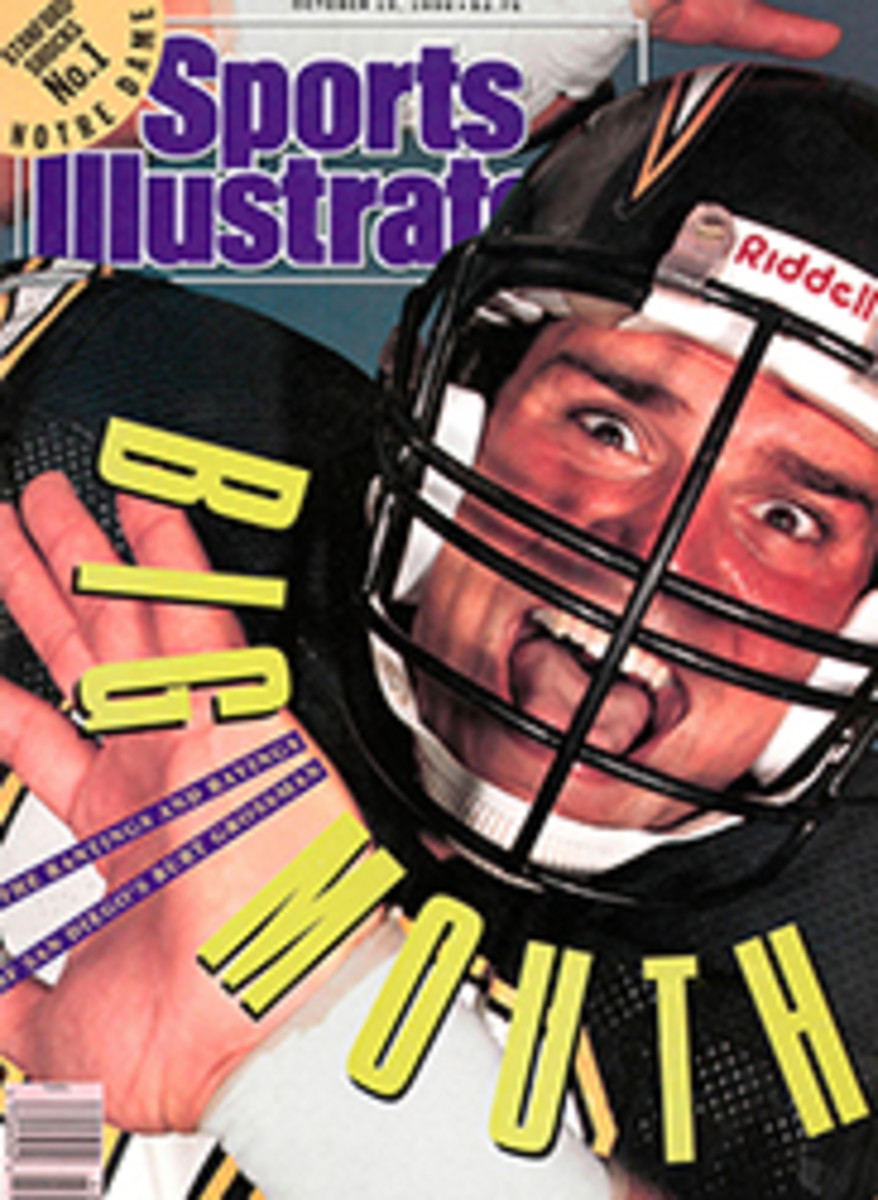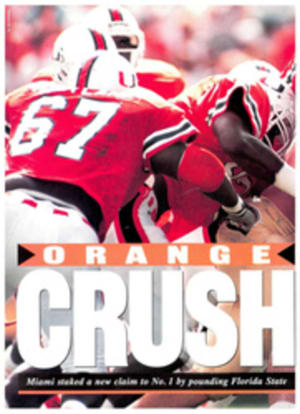
A COLLEGE KID WITH PLENTY OF MUSCLE
Although it would be a bit of a stretch, the evolution of the American muscle car might be measured by using Tommy Kendall as a 6'4" yardstick. Kendall, who drives for Chevy, stars in the Sports Car Club of America's Trans-Am Championship, which was born the same year he was, 1966. At its inception, the series bulged and throbbed with pumped-up Ford Mustangs, Chevy Camaros, Dodge Chargers, Plymouth Barracudas and AMC Javelins—willful machines of steel that thundered and roared and laid thick black tire tracks wherever they went. But they didn't stop very well, and they handled like—let's just say that plenty of muscle was needed to control them. What's more, the series' drivers, men like Parnelli Jones and Dan Gurney, were the same: strong, steely and in a hurry. You didn't want to get in their way.
Zoom ahead a quarter of a century. Now we have Kendall, who won this year's 15-race Trans-Am series with 11 top-five finishes, including six victories, four of those at track-record speeds. But the Chevy Beretta he drives, like the cars of his competitors, is a midsized package of advanced technology, developed—at no small cost—by engineers at, in Kendall's case, General Motors. The car's V-6 engine is watched over by computer chips, and its aerodynamic carbon fiber-Kevlar body, scarcely knee-high at the fenders, is more svelte than it is muscular. Some things about racing don't change, however. Cars like Kendall's still return often to the garage in pieces after a race. Drivers will be drivers.
Kendall suits his car. He's a driver of the 1990s, and he stands a good chance of becoming the driver of the '90s. In five years of professional racing, he has won five series championships. Of the 64 races he has entered, he has finished among the top five 54 times and won 21 times. And because many of the races were endurance events lasting from three to 24 hours, he has racked up lots of hours of experience.
In the meantime, he also has racked up almost enough credit for a degree in economics at UCLA, which he hopes to have by March. One of Kendall's favorite lines is that he has squeezed four years of college into seven. He started at UCLA the same year he began entering amateur races, in 1984, and as his successes on the track mounted, so did the sport's demands on his time and concentration. Last year, when he ended up third in the Trans-Am series as a rookie in that class, racing and testing required that he travel about 200 days. He kept up with his studies by bringing his books with him. Although he admits that "at a race it's really hard to change gears and open the books," he has maintained a 2.9 GPA. "Luckily, I have a memory that's almost photographic," says Kendall, "and it has enabled me to cram for a lot of exams."
Kendall's height is the only drawback that team owners see in him. It may keep him from entering Indy Car or Formula One events, because to minimize aerodynamic resistance, those open-wheel racers are designed for drivers who are between 5'8" and 5'10". In all likelihood, Kendall's future lies in bigger, 200-mph stock cars. Just last month he drove on an oval track for the first time, on the‚Äö√Ñ√∂‚àö√±‚àöœÄ-mile North Wilkesboro (N.C.) Speedway. Kendall did about 150 laps with three-time NASCAR champion Dale Earnhardt sharing the track in another race car. First Earnhardt took the lead, to show Kendall the basic technique, which is vastly different from road racing's. Then Earnhardt followed Kendall to see how well the oval-track newcomer did. Said an impressed Earnhardt, "He's definitely got his act together as far as how he's approaching everything—not wild and crazy like most of us were when we started. He's young to know where he's going to go in racing, but he's got a good bit of smarts to get him there."
Kendall was born in Santa Monica, Calif. His father, Chuck, was a defensive back for the Houston Oilers in 1960. When the elder Kendall's football days were over, he began what was to become a successful real estate career in Southern California. Chuck's wife, Claire, gave up modeling to raise four sons, of whom Tommy is the second. She recently resumed her career at age 51 and was on the February cover of Walking magazine.
Tommy got a good bit of grease under his fingernails growing up, thanks to Chuck, a longtime car-racing buff. As a teenager he was a gofer for his dad's sports-car racing team. Tommy remembers that he "lived to be able to drive the car back from the pits to the paddock at the end of the day."
Chuck still enters West Coast sports-car races in his Mustang, prepared in his shop in Glendale, Calif. However, the shop's principal claim to fame is that it's a place where motorcycles are customized for movies and for celebrities like Arnold Schwarzenegger. One recent project, a Harley-Davidson chopper, was sold for $42,000—used—to a rock musician no one over 14 has ever heard of. Tommy calls the Harleys that come out of the shop Hawg Dawgs. He sometimes goes cruising with his Hawg friends, who make him ride on the point—on the theory that his preppy looks provide terrific camouflage when the police happen by.
For his son's 16th birthday, Chuck sent Tommy to the Bob Bondurant School of High Performance Driving, in Sonoma, Calif. Claire took the five-day course with Tommy because it sounded like fun. Claire, however, still wonders about the sport that has seized three male members of her family. (Tommy's older brother, Bart, 25, races sports cars, and he has done racing commentary for ESPN.) "My heart flutters pretty hard when I watch them race," Claire says. "It's hard not to worry, when you see your flesh and blood, someone you raised from diapers, and suddenly he's out there going 150 miles per hour with other men trying to beat him—any way they can."
After he completed the Bondurant school, Tommy began racing in the International Motor Sports Association's GTU series in a five-year-old Mazda RX-7. Dad footed the bill. In his first full year of racing, 1986, he was leading the points standings after three events, so Mazda hired him. Tommy went on to win the championship in '86 and '87 in a Mazda and in '88 in a Beretta.
"There's no way to get involved in racing without some financial support, whether it's from family or not," says Tommy. "I'm never ashamed of that support. The pitiful thing would be to have all the opportunity I've had and not make the most of it. But I kept hearing, 'You never would be driving if it weren't for your father buying your ride.' So to prove myself, I just drew a hard line after '86: Never take a ride in a car that didn't have a sponsor. Looking back on it, I could have easily ended my career right there. It was an overreaction. But it forced me to become a paid driver right away."
Behind the wheel, Kendall is smooth, smart, consistent and aggressive—but not too aggressive. While he isn't afraid to risk a hit, he doesn't look for trouble. He's also sensitive to the limits of a car and extremely easy on it. Says Dave King, manager of the ICI/Olivetti Chevrolet Beretta Race Team, "When Tommy comes in, the brakes, clutch and tires look as if he's never used them."
Says Kendall, "There's not a whole lot of magic to race driving. A lot of it is just seat time, and after that it's really a mental deal. Natural ability only gets you so far. When you get to a level like Trans-Am, the talent is pretty equal. What sets one driver apart from another is how hard you work. I've got a buddy who's always telling me, 'The only difference between you and Rick Mears is experience.' "
Kendall believes he'll be moving up to stock cars in 1991. In addition to his oval track tryout, he has raced in three stock car events, two at Watkins Glen (N.Y.) and one at Sears Point (Calif.), both of which are road courses. He led two of those races before crashing—a blown tire caused one wreck, the other was to avoid a spinning car—and finished fifth in the third. But the NASCAR circuit isn't his only option. He could move to IMSA's GTP class for prototypes; he has entered four GTP races this year, driving a Spice-Chevy to third place at Lime Rock Race Park in Lakeville, Conn.
The mixture of California college boy driver with a Southern good ol' boy stock-car team might seem to be asking for trouble, but any preppy who can ride point in a pack of choppers knows how to mix. Kendall, in fact, loves the way things are done on the NASCAR circuit. "Here's the best way to describe what racing stock cars is like," he says. "We had to raise the exhaust pipes to clear the track on some of the corners, and my chassis man jacked the car up and dropped it down on the pipes, on top of a tire. 'There,' he said. 'Smashed it perfect.' To use the words smash and perfect in the same sentence pretty much defines stock car racing."
As for his schoolwork, he says, "I came to the realization that I was staying in college simply because I wanted to finish something I started. My only career ambition is to drive as long as I can. The business world has appeal, but I have no plans to do anything with my economics degree, unless the racing stops going well. I can't imagine ever not wanting to drive."
TWO PHOTOS
GEORGE OLSON
After team manager Dan Binks belts Kendall into his car, fenders and hood often go flying.
PHOTO
CRAIG MOLENHOUSE
Kendall hits the books at UCLA and the street on his Hawg Dawg.

